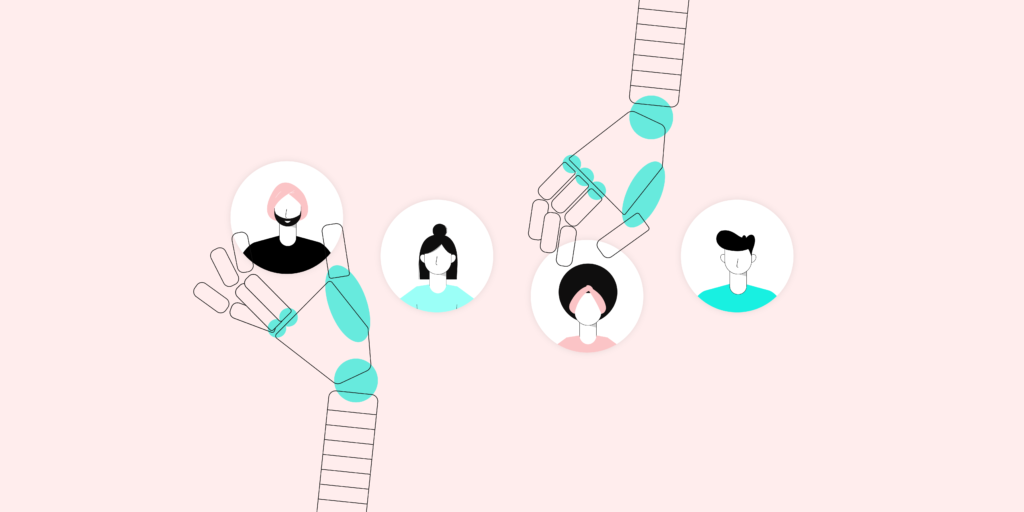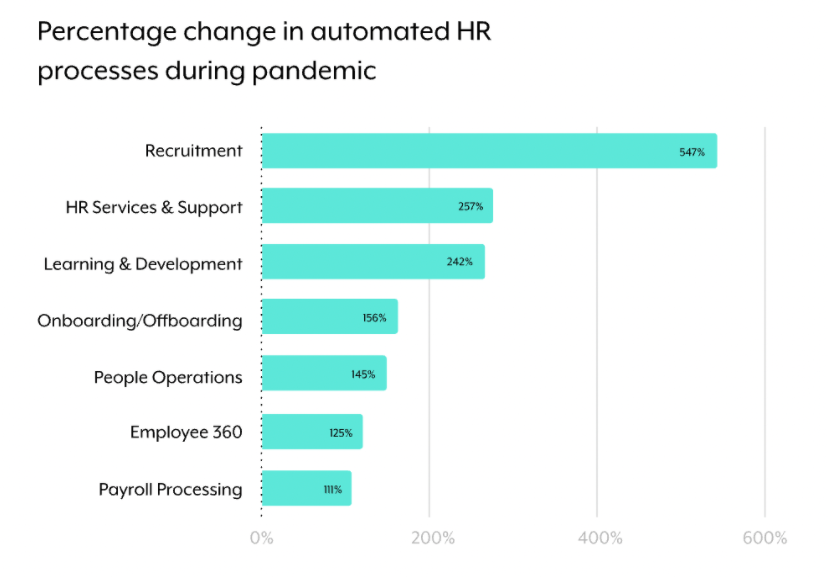Enterprise automation has been booming across all departments and processes since the start of the pandemic, and HR is no exception.
When studying how hundreds of our clients have changed the way they work in the face of a new workplace landscape, we found that HR teams are automating now more than ever. Moreover, this increase can be found across key processes, whether it’s recruitment, onboarding, or offboarding.
Why are more and more organizations automating these processes? And how can these automations work in practice? You can read on to learn the answers to both questions.
1. Take the tedium out of recruiting
Although recruitment makes up only 6% of all HR automations, it has shown the most growth thus far, with a massive increase of 547% year-over-year. That’s owed in large part to the shift to remote and hybrid work models.
Automating the recruiting process not only allows businesses to find and hire the right talent in a new era of work, it also makes the experience easier on candidates, setting up a positive rapport with talent early on.
Interview scheduling automations have been especially useful for hiring teams.
It may be one of the more tedious recruitment tasks, but interview scheduling is important, as it’s one of the first impressions candidates have when they interact with your business. It’s worth it to make the process as easy as possible for everyone involved.
Here’s one way to automate it:
1. When you change a candidate’s stage to “interview” in your ATS, your chatbot creates a channel in your business comms platform that includes every interviewer.
2. In that channel, an interviewer can click a button that prompts them to set an interview date. The chatbot then displays a popup that allows them to pick the date and time.
3. The interview gets scheduled both in the ATS and on a calendar platform like Google Calendar. The chatbot also invites other interviewers and provides resources, like a link to the candidate’s profile in your ATS, and a link to the interview kit.
Related: 3 common integrations between your ATS and HRIS
2. Support employees at scale with an intelligent helpdesk
Our research found that the second most automated process in HR is for services and support, with a growth rate of 257% year-over-year.
It’s easy to understand why HR teams are moving in large numbers to automate this area.
HR fields a lot of frequently asked questions on a daily basis, whether it’s around benefits, holidays, or other HR-related subjects, and resolving them is time consuming and repetitive.
Thankfully, FAQs are easy to automate.
One way companies have done this is by implementing an IT or HR bot to create an internal helpdesk. You can see how it works here:
Taking these questions off your HR department’s plate helps free them up to deal with more pressing challenges and bigger projects. Instant answers through a helpdesk bot also saves time for the rest of your employees, as they can get instant answers to many of their questions.
Related: A complete guide to HR system integration
3. Make learning and development opportunities more accessible
As more and more professionals across industries look to up-level their skills in a changing world, learning and development workflows are being automated at an increasing pace—242% growth YOY—to keep up with demand.
One way to achieve this is by applying a similar automation to the aforementioned HR/IT helpdesk:
1. Using your company’s business communications platform, like Slack or Microsoft Teams, employees can use a bot to ask questions related to their work. For example, “how do I use [platform X] to do [task Y]?” or “What’s the talk track against [competitor X]?”
2. Based on information that already exists within your company’s internal knowledge base, such as Guru, the bot surfaces the appropriate articles.
This strategy is a great way to supplement more formal types of L&D, such as certifications or professional development programs.
Popular Namely integrations
4. Onboard new hires with ease
The single most commonly automated processes in HR are onboarding and offboarding, making up 34.5% of all HR automations. In the case of onboarding, companies are turning to automation in droves to address the challenges that come with bringing remote workers onboard and to ensure that all new hires can hit the ground running.
One way you can support your new hires is by instantly provisioning the apps they’ll need by their first day.
Here’s how we do it at Workato.
- Once a new hire notice (an email that alerts key stakeholders about a new hire) gets sent from an HRIS, the workflow gets triggered.
- An HR chatbot sends a message to the new hire’s manager via the business communications platform, asking them to select the apps they need access to.
- Once the manager makes their selections, the BT team receives a message in a channel in the business comms platform, alerting them of the requested apps.
- Anyone who belongs to that channel can review the request, check if there are licenses available across the relevant apps, and then approve or reject the request.
- Once approved, the bot sends an approval notice via a message in the business comms platform.
In addition, new hires can gain, lose, or change access to any apps at any time. At Workato, we manage these requests through a chatbot called “Firefighter Bot.”
Related: 3 IT automation trends that show how organizations engage in digital transformation
5. Lessen the stress of offboarding
Just as companies have had to automate onboarding in a new era of remote work, they’ve also had to adapt offboarding to facilitate an easy and secure process in a remote setting.
Offboarding can be hectic on its own, and that’s not even taking into account the security risks that are involved. For example, over half of employees leaving a company take valuable data with them; whether intentional or not, this in itself can pose a lot of potential problems, from HIPAA or GDPR violations to exposing trade secrets or proprietary information.
Mitigating these risks doesn’t have to take a lot of work, though. Automating the offboarding process can remove some heavy lifting on the part of both the HR team and the departing employee, ensuring a smooth transition for all.
One way companies have achieved this is by automating the process of deprovisioning apps and equipment. Here’s how it works.
- Once an employee is marked as terminated in an HRIS like Workday, the workflow gets triggered.
- The workflow creates tickets related to de-provisioning the employees’ access to apps and equipment.
- At the end of the employee’s final day, their access is removed from relevant groups in a service like Active Directory.
- Finally, a security platform like SentinelOne deactivates the employee’s laptop access.
Related: HR automation stats that highlight how the employee and candidate experience is evolving
Automate HR to adapt to a new way of working
The way we manage candidates and employees is changing. With the global workforce becoming increasingly remote, companies will need to adapt in order to support their people and scale their teams effectively.
When we automate the most tedious, time-consuming processes, we can get back to connecting with our employees on a personal level, making sure they’re supported when they need us most. At the same time, automation can empower employees and candidates to get their needs met in a way that suits their preferences.

Ready to streamline your HR processes?
Schedule a demo with Workato, the leader in integration-led automation, to learn how we can help.

